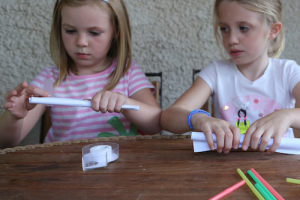Introducing STEM (Science, Technology, Engineering, and Mathematics) activities to young children can be a fun and educational way to foster their curiosity and develop essential skills.
Engaging kids between the ages of 3 and 5 in hands-on STEM activities can help them explore the world around them, build problem-solving abilities, and encourage critical thinking.
To get you started, here are easy STEM activities for 3 5 Year Olds specifically designed for preschoolers, featuring simple materials and age-appropriate concepts.
These activities will not only provide hours of entertainment but also lay the foundation for a lifelong love of learning in the fields of science, technology, engineering, and mathematics.
Let’s dive in and watch your little ones’ imaginations soar as they embark on these exciting STEM adventures!
Sink or Float Experiment:

Introduce the concept of buoyancy to young children with a simple sink or float experiment. Fill a basin with water and gather a variety of objects such as a toy car, a rubber duck, a sponge, and a small rock. Encourage the children to predict whether each object will sink or float before placing them in the water. Observe and discuss the results together, noting the characteristics of objects that sink and those that float. This activity not only introduces the scientific method but also helps develop critical thinking and observation skills.
Building with Blocks:

Building structures with blocks is an excellent way to introduce engineering and spatial reasoning to young children. Provide a variety of building materials such as wooden blocks, plastic bricks, and cardboard tubes. Encourage the children to construct different structures, such as towers, bridges, and houses. Ask open-ended questions to prompt their thinking, such as how to make a tower taller or how to create a stable bridge. This activity promotes creativity, problem-solving, and fine motor skills.
Nature Scavenger Hunt:

Take the children on a nature scavenger hunt to explore the world around them and introduce basic scientific concepts. Create a checklist with items such as leaves, rocks, flowers, and insects. Guide the children to observe and collect these items while discussing their characteristics and functions. Encourage them to ask questions and share their findings. This activity fosters curiosity, observation skills, and an appreciation for the natural world.
Related: 20 Wonderful Wall Games for Kids
Color Mixing:

Explore the wonders of color mixing by conducting a simple experiment using primary colors. Provide three small cups filled with water and add a few drops of red, yellow, and blue food coloring to each cup. Give the children pipettes or droppers to transfer the colored water and encourage them to mix different combinations in clear containers. Observe the changes in color and discuss the results. This activity introduces the concept of primary and secondary colors, as well as promoting fine motor skills and creativity.
Building a Simple Circuit:

Introduce basic concepts of electricity and circuits with a hands-on activity. Provide materials such as batteries, LED lights, and copper wire. Demonstrate how to connect the components to create a simple circuit that lights up the LED. Encourage the children to explore and experiment with different ways to connect the components. Discuss the flow of electricity and how the circuit works. This activity promotes problem-solving, critical thinking, and an understanding of basic circuitry.
Related: 20 Brilliant Geoboard Activities for Kids
Magnetic Exploration:

Introduce the concept of magnetism by providing a variety of magnetic and non-magnetic objects such as paper clips, buttons, plastic toys, and wooden blocks. Allow the children to experiment with magnets and explore which objects are attracted to them. Encourage them to sort the objects into two categories: magnetic and non-magnetic. This activity promotes observation skills, critical thinking, and an understanding of basic magnetic properties.
Shadow Play:

On a sunny day, take the children outside to explore shadows. Provide objects of various shapes and sizes, such as toys, leaves, and blocks. Encourage the children to experiment by placing the objects in the sunlight and observing the shadows they cast. Ask questions about the size and shape of the shadows and how they change when objects are moved closer or farther from the light source. This activity introduces basic concepts of light and shadow and promotes observation and prediction skills.
Sensory Science:

Engage the children’s senses by creating a sensory science station. Set up different sensory bins filled with materials like rice, sand, water beads, or shaving cream. Add small objects like measuring cups, funnels, or toy animals for exploration. Encourage the children to touch, pour, and explore the materials while discussing their observations. This activity promotes sensory development, fine motor skills, and scientific exploration.
Nature Engineering:

Take a nature walk with the children and encourage them to collect natural materials like sticks, leaves, and rocks. Back indoors, provide playdough and challenge the children to use natural materials to build structures or sculptures. Discuss the different properties of the materials and how they can be used in construction. This activity promotes creativity, problem-solving, and an understanding of basic engineering principles.
Sink or Swim Boat Challenge:

Using aluminum foil, challenge the children to design and build boats that can float in a container of water. Provide various materials such as straws, popsicle sticks, and tape to assist with construction. Encourage the children to experiment with different boat designs and sizes to see which ones float and hold the most weight. This activity introduces the concepts of buoyancy, design thinking, and problem-solving.
Bubble Science:

Engage the children in the fascinating world of bubbles. Provide bubble solution and various tools such as bubble wands, straws, and pipe cleaners. Encourage the children to experiment with different bubble sizes and shapes by blowing bubbles or using the tools provided. Discuss what makes bubbles form and pop, and how different factors like air and surface tension affect them. This activity promotes curiosity, observation skills, and understanding of basic scientific principles.
Pattern Play:

Introduce patterns to young children using objects like colored blocks, buttons, or stickers. Start a simple pattern and invite the children to continue it, or let them create their own patterns. Encourage them to explore patterns in different ways, such as color, shape, or size. This activity develops critical thinking, pattern recognition, and mathematical concepts.
Gardening Exploration:

Allow the children to get their hands dirty and learn about plants and nature through gardening. Provide small pots, soil, and seeds or seedlings. Guide the children in planting and caring for their own plants. Discuss the growth process, parts of a plant, and the importance of sunlight and water. This activity fosters a connection with nature, observation skills, and an understanding of the plant life cycle.
Shape Hunt:

Take the children on a shape hunt adventure, whether it’s indoors or outdoors. Provide them with a list of shapes such as circles, squares, triangles, and rectangles. Encourage them to search for objects that match each shape. Discuss the attributes of the shapes they find and how they can be found in everyday objects. This activity promotes shape recognition, observation skills, and spatial awareness.
Sensory Experiments:

Engage the children in sensory experiments that explore different materials and their properties. Set up stations with materials like sand, water, clay, and rice. Provide tools such as spoons, funnels, and cups for exploration. Encourage the children to manipulate the materials and observe their characteristics, such as texture, weight, and responsiveness to touch. This activity stimulates the senses, develops fine motor skills, and encourages scientific exploration.
Shadow Tracing:

On a sunny day, bring out large sheets of paper and various objects with interesting shapes. Place the objects on the paper and let the children trace their shadows with pencils or crayons. Encourage them to compare the shapes of the objects and their corresponding shadows. Discuss why the shadows change shape and size throughout the day as the position of the sun changes. This activity promotes observation skills, critical thinking, and understanding of light and shadow.
Straw Rockets:

Engage the children in a fun and interactive engineering activity by making straw rockets. Provide paper, markers, scissors, and tape along with flexible straws. Help the children decorate and cut out rocket shapes from the paper, then attach them to the straws using tape. Encourage them to blow through the straw to launch their rockets and observe how far they fly. Discuss the concepts of force, motion, and trajectory. This activity stimulates creativity, fine motor skills, and understanding of basic physics.
Animal Tracks Exploration:

Take the children on an outdoor adventure to explore animal tracks. Look for tracks in mud, sand, or snow, or use pictures or plastic animal footprints if outdoor exploration is not possible. Encourage the children to observe and identify different animal tracks. Discuss the unique features of each track and encourage them to make predictions about the animals that made them. This activity promotes observation skills, critical thinking, and an appreciation for nature.
Sensory Sink or Float:

Create a sensory bin with various objects and fill it with water. Gather objects that sink, float, or do both, such as plastic toys, wooden blocks, and foam shapes. Invite the children to explore and predict whether each object will sink or float by placing them in the water. Encourage them to use their senses to observe the objects’ textures, weights, and buoyancy. This activity combines sensory play with scientific exploration and fosters observation skills and critical thinking.
Straw Building Challenge:

Provide the children with a set of straws and connectors like pipe cleaners or tape. Challenge them to build structures using the straws and connectors, such as towers, bridges, or houses. Encourage them to experiment with different designs and discuss what makes their structures strong or stable. This activity promotes creativity, problem-solving, and an understanding of basic engineering principles.


